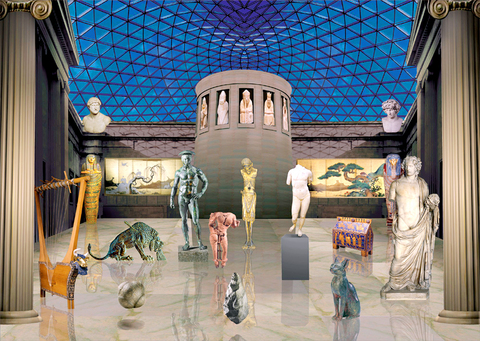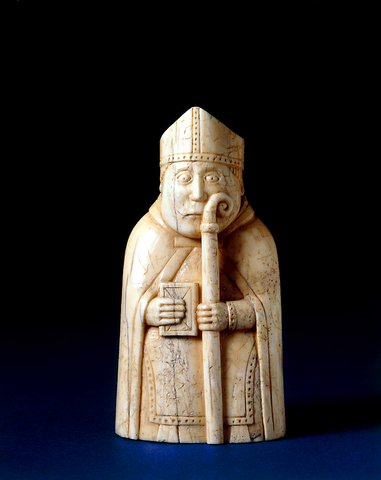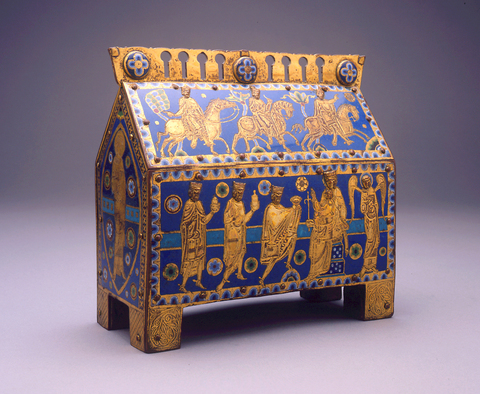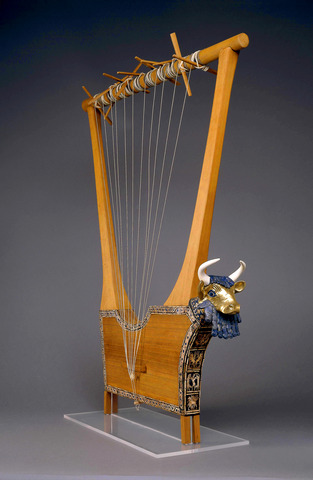The born again National Palace Museum (NPM) celebrates today the end of three years of renovations with a first-class exhibition of artifacts loaned by the British Museum, some historical gems from its own vaults and a lively series of outdoor cultural events.
Treasures of the World's Cultures: The British Museum after 250 Years is a show comprising 271 works with an estimated value of NT$5 billion, stretching back from the "dawn of human civilization" in Africa to the "unraveling cultures of the Americas." Must-see items include the "Unlucky Mummy," one of the world's earliest instruments, busts from Greece and Rome, a reliquary, Mayan statues and drawings by Leonardo da Vinci.
Putting together Chinese history from the National Palace Museum (NPM) with artifacts from other equally ancient civilizations collected by the British Museum provides a unique chance to view first-hand the fruits of 5,000 years of civilization.

PHOTOS COURTESY OF NPM
"This is the world's heritage on one site. There's always a risk with touring exhibitions of this kind that we are not seeing the original items or second- or third-rate examples from a collection. This is the genuine stuff and though I think, personally, it is a bit of risk for ancient pieces like this to go on display so close to the general public, it is a wonderful opportunity to look around here and then go around the Palace Museum to compare articles from China from a given period," said the director of the British Trade and Cultural Office Michael Reilly.
"We often think about what it is about our country that makes us unique but actually, by looking around at these artifacts on the same site, you realize that it may have been cross-fertilization that led to many advances."
For example, Reilly said, the concurrent Sung Dynasty Rare Books exhibition has records from the imperial Chinese court showing officials traveled widely to disperse and gather information that led to significant cultural development.

Deputy director of the British Museum, Andrew Burnett, emphasized that seeing a copy or looking at pictures on the Internet was "no substitute for viewing the real object, such as the tools used by the first humans or the great drawings by Da Vinci."
"These achievements of man show that Africa is so much more than just a place of famine, that Islam has produced fantastic instruments of significance and that Iraq was one of the earliest sources of civilization and not just the place we know now," Burnett said, amplifying his theme of history being able to teach us about the present and increase understanding between cultures.
NPM has conveniently organized 30-, 60- and 120-minute visiting plans of the exhibition to cover the best-known artifacts. It has also split the Treasures of the World's Cultures into 13 sections that are given imaginative titles such as "glimpses of morning glory," "in pursuit of immortality" (ancient Egypt), "land of the gods" (Greece and Rome) or "tranquil and profound" (Southeast Asia).

Starting with stone chopping tools from around 2.5 million years ago we are offered a package tour-like view of history. A beautifully restored lyre, which is estimated to be 4,500 years old, is one of two retrieved from the grave of Queen Puabi. It was found with a sacrificial victim lying against it, the bones of her hand placed against where the strings would have been.
With history comes legend, but the "Unlucky Mummy" story is apocryphal. Supposedly, the case contained the remains of the Princess of Amen-Ra and was bought by an Englishman in the 1890s. The curse of the mummy killed him and many other people and subsequently watchmen at the British Museum refused to go near it. Eventually, it was sold to an American who went down with the Titanic. Actually, the story was a newspaper hoax and the mummy never left the British Museum … until now.
Back to reality, the Statuette of Hermes is an outstanding example of classical art, which even now informs our idea of the perfect body. History would not be complete without the rise and fall of civilizations and the section on Rome has an impressive selection of treasures. Though global in its scope the exhibition is Eurocentric. This is to be expected. After all, when the British Museum was founded in 1753 Britain was developing its own empire and saw the world in its own image.

As such, the sections that cover India and Japan are not the strongest parts of the exhibition with a headless Indian goddess and paintings from the Edo period. These familiar items reinforce stereotypical views of the countries' cultures. This is not a criticism, however, since many visitors would be disappointed if these iconic objects held by the British Museum were not on view.
The Islamic (in particular) African, Pacific and American sections are more illuminating, since they include objects that have not had such popular public exposure. Labeling of the works is in Chinese and English and there are descriptive introductions to the various sections of the exhibition that frame the works well. Best of all, you won't get a better chance to get up close to history, as many items are not behind glass and have not been fenced off.
Introducing the exhibition, NPM Director Lin Mun-lee (林曼麗) said it was designed to celebrate the end of renovations to the museum that opened in a Taipei suburb, 1965. The original National Palace Museum was founded 1925, in Beijing, but the collection dates as far back as the Sung Dynasty (960 AD to 1279) when the Emperor Taizong (太宗) started hoarding the finest examples of Chinese art.

In addition to earthquake proofing the main gallery areas, Lin said the new exhibition spaces, digital learning areas, multimedia screening room and children's learning area would make NPM more than just a repository for history, but also a place where education and socializing would take place.
Three "Grand View" exhibits set up for the reopening complement the permanent displays and will run until the end of March. The grand view includes Ju Ware from the Northern Sung Dynasty, Painting and Calligraphy of the Northern Sung and Sung Dynasty Rare Books.
Additionally, NPM has set out a weeklong series of outdoor concerts and activities in the museum's front plaza. An arts fun fair inspired by Sung dynasty lifestyles will feature handicrafts from local artists. On Friday, there will be a performance (4:30pm onward) by Ming Hwa Yuan Taiwanese Opera troupe, the Ju Percussion Group will play on Feb. 10 and U-Theatre is on Feb. 11.


This is the year that the demographic crisis will begin to impact people’s lives. This will create pressures on treatment and hiring of foreigners. Regardless of whatever technological breakthroughs happen, the real value will come from digesting and productively applying existing technologies in new and creative ways. INTRODUCING BASIC SERVICES BREAKDOWNS At some point soon, we will begin to witness a breakdown in basic services. Initially, it will be limited and sporadic, but the frequency and newsworthiness of the incidents will only continue to accelerate dramatically in the coming years. Here in central Taiwan, many basic services are severely understaffed, and

Jan. 5 to Jan. 11 Of the more than 3,000km of sugar railway that once criss-crossed central and southern Taiwan, just 16.1km remain in operation today. By the time Dafydd Fell began photographing the network in earnest in 1994, it was already well past its heyday. The system had been significantly cut back, leaving behind abandoned stations, rusting rolling stock and crumbling facilities. This reduction continued during the five years of his documentation, adding urgency to his task. As passenger services had already ceased by then, Fell had to wait for the sugarcane harvest season each year, which typically ran from

It is a soulful folk song, filled with feeling and history: A love-stricken young man tells God about his hopes and dreams of happiness. Generations of Uighurs, the Turkic ethnic minority in China’s Xinjiang region, have played it at parties and weddings. But today, if they download it, play it or share it online, they risk ending up in prison. Besh pede, a popular Uighur folk ballad, is among dozens of Uighur-language songs that have been deemed “problematic” by Xinjiang authorities, according to a recording of a meeting held by police and other local officials in the historic city of Kashgar in

It’s a good thing that 2025 is over. Yes, I fully expect we will look back on the year with nostalgia, once we have experienced this year and 2027. Traditionally at New Years much discourse is devoted to discussing what happened the previous year. Let’s have a look at what didn’t happen. Many bad things did not happen. The People’s Republic of China (PRC) did not attack Taiwan. We didn’t have a massive, destructive earthquake or drought. We didn’t have a major human pandemic. No widespread unemployment or other destructive social events. Nothing serious was done about Taiwan’s swelling birth rate catastrophe.